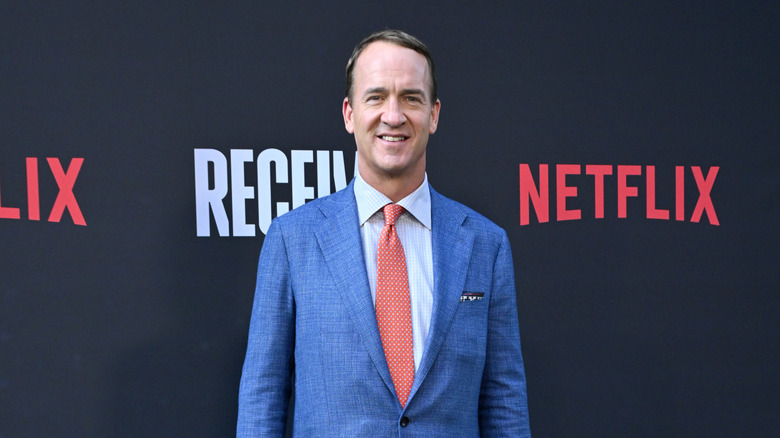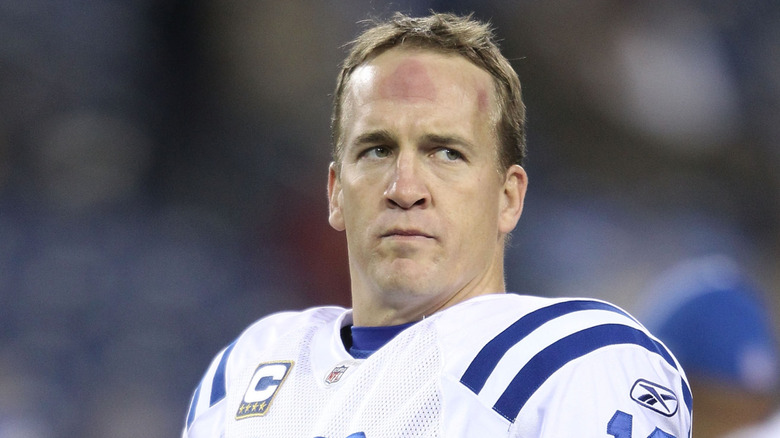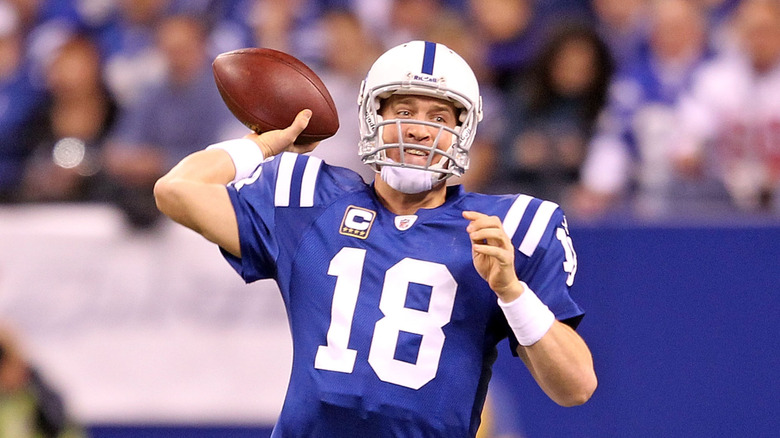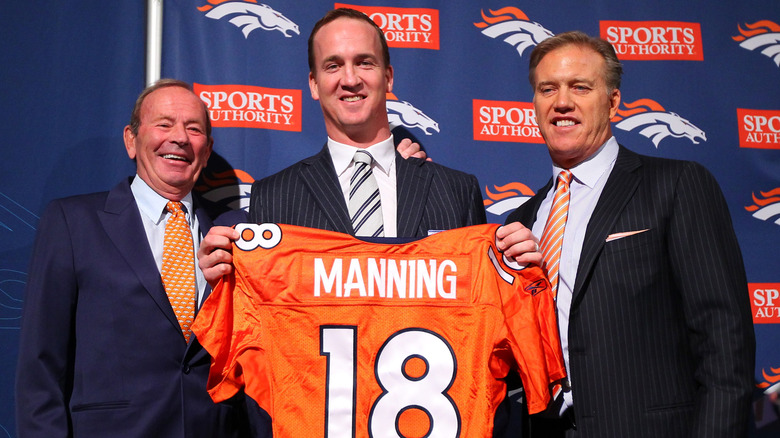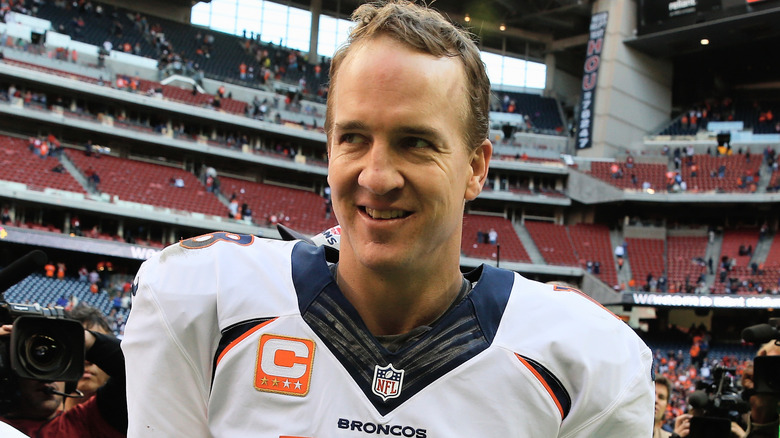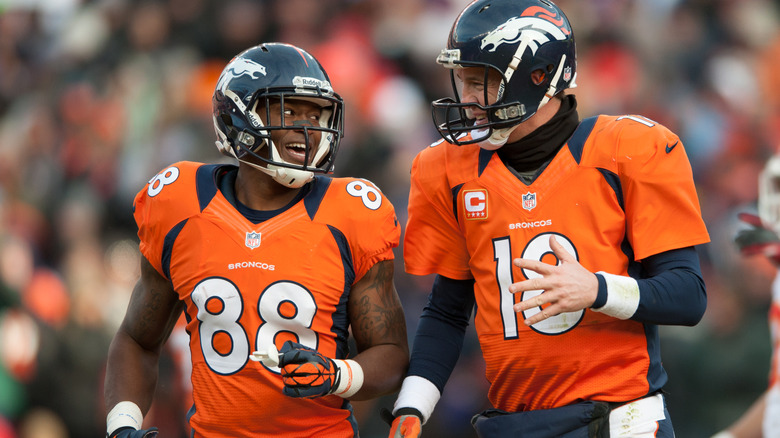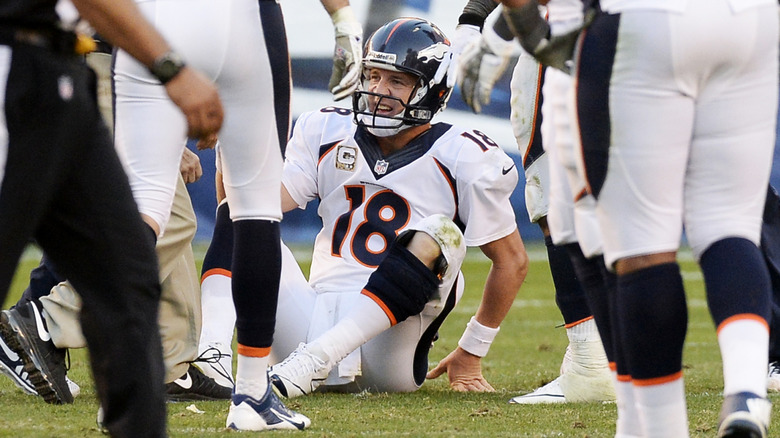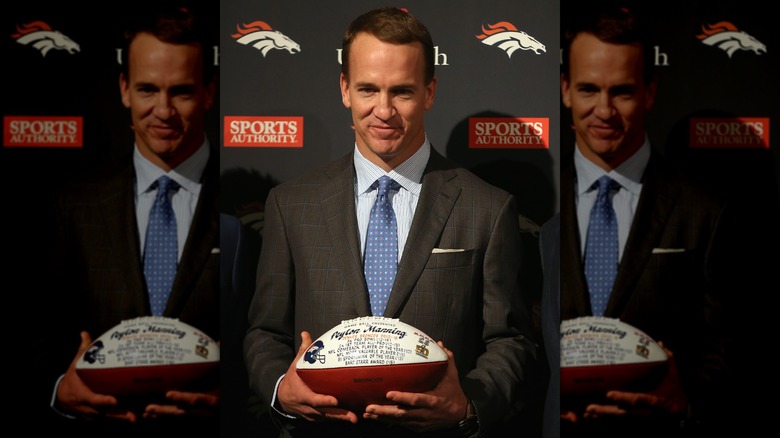Tragic Details Of Peyton Manning
Peyton Manning has inarguably solidified his legacy as one of the greatest quarterbacks in the NFL's history. After being the first overall pick during the 1998 NFL Draft, Manning played with the Indianapolis Colts through 2011, then finished his career with the Denver Broncos before retiring in 2016. By then, he had two Super Bowl rings, had won at least once against all 32 NFL franchises, and held a slew of records, including the most passing yards, touchdown passes, and consecutive seasons with at least 25 touchdown passes in the NFL.
And yet, despite all of these successes, Manning also faced his share of hardships. From his on-field rivalry with fellow GOAT Tom Brady to serious health issues, the quarterback's storied 18-year career also had its downs. Indeed, a number of consecutive health scares nearly sidelined him for good at the height of his career. These are the tragic details of Peyton Manning.
Peyton Manning had five neck surgeries in less than two years
Peyton Manning had to overcome more than just challenges on the field to become one of the greatest football players of all time. The legendary quarterback was born with a congenital spinal-cervical weakness, a condition similar to that which caused his older brother Cooper to give up his own football dreams as a teen. Devastatingly, a doctor confirmed that Manning's own neck curvature could prove problematic in the future and yet, he managed to play without issue for almost two decades.
Unfortunately, that all changed in February 2010 when Manning had to undergo surgery for a pinched nerve in his neck. Then, in 2011, he herniated a disc (also in his neck) and began experiencing weakness in his throwing arm. That May, he had surgery again but the procedure left him with an even weaker throwing arm and difficulty gripping. "You're certainly concerned as far as being able to do your job," he told The Washington Post, recalling how he pushed doctors to take a closer look. It was good he did because he had re-herniated the disc and needed yet another surgery. However, it was by no means a golden cure. The first time he tried to throw a football afterwards, Manning told the outlet, "The ball nose-dived after about five yards." The football great would ultimately undergo four neck surgeries in 19 months – all trying to fix the same problem and culminating with a single-level anterior cervical fusion in September 2011.
Peyton Manning underwent neck fusion surgery in his mid-thirties
After several unsuccessful surgeries to address the pinched nerve causing weakness in his throwing arm, Peyton Manning finally opted for a more serious but more effective procedure in September 2011. As Dr. Sean McCance, a board-certified orthopedic spine surgeon, explained on his blog, the single-level anterior cervical fusion that Manning underwent involved removing the damaged disk from his spinal cord, filling the space it left with a bone graft, and finally fusing the two vertebrae together with help from a plate and screws.
Initially, the results appeared less promising than those from his prior surgeries. When doctors recommended Manning throw darts to build up his arm strength, he told The Washington Post that was easier said than done. "I could barely get the thing to stick," he recalled. He was a long way away from being able to throw (or catch) a football like he once did and rumors of retirement began swirling. However, his doctor kept hope and offered a promising update that December: Manning's neck had fully healed. "[It] has achieved firm fixation," Dr. Robert Watkins explained, per CBC. "Peyton will now be allowed to increase the intensity and breadth of his workouts as tolerated." That is exactly what he did, but his recovery may have been a bit too slow for Indianapolis Colts owner Jim Irsay.
Was he fired from the Colts because of his health?
Peyton Manning's back-to-back neck operations forced him to miss the 2011 NFL season, but he was far from ready to retire. As he quietly worked to regain his strength and prowess post-op, Indianapolis Colts owner Jim Irsay told ESPN in February 2012 that he was happy for Manning to stay with the team. "We want him back if he wants to come back," Irsay assured after doctors cleared the NFL's only four-time MVP to start training and playing again.
At the same time, though, Irsay noted that Manning hadn't passed a physical exam carried out by the Colts and, come March, he decided to drop the quarterback after a whopping 14 seasons together. The headline-making decision meant that the Colts no longer had to pay Manning a $28 million bonus mandated by his contract. Moreover, they didn't have to risk him missing any more games in the 2012 season. While Irsay didn't give a precise reason for the choice, it's easy to imagine that Manning's health played a critical role. What we do know for sure, though, is that it's not what the footballer wanted. "There is no other team I wanted to play for," Manning said candidly, per ESPN.
He had to relearn to play the game
Following his dismissal from the Colts, Peyton Manning joined the Denver Broncos in 2012 and stayed with the team through his final NFL season in 2015. Watching him play, fans would be hard-pressed to criticize his impressive recovery and yet, it was anything but easy.
Manning kept much of his ordeal under wraps before finally sharing details with The Washington Post in 2013. As it turns out, following his initial surgery in early 2011, he found it hard to hold a football – let alone throw or catch one. At the gym, he could only train with five-pound dumbbells. When he tried to throw a ball with brother Eli, he performed so poorly that the latter actually told him, "It looks like you can't finish the throw and get anything on it." What's more, he struggled to hit any sort of mark. "It's hard to explain but I kind of lost awareness of my arm in space," Manning recalled.
It wasn't until after his final fusion surgery that the MVP started pushing his performance back to normal, but it took time and dedication. "I had to relearn," he said of the game. For help, Manning turned to Duke head coach David Cutcliffe whom he first met when he was just 18. Together, they got to work, starting small to get his strength back. "We started at ground zero," Manning admitted.
Peyton Manning was 'absolutely devastated' over the death of a former teammate
When Peyton Manning moved over to the Denver Broncos in 2012, he formed a close bond with wide receiver Demaryius Thomas. The two were teammates until Manning's final season in 2015 and it seems their friendships reached off the field as well. When Thomas died suddenly of "complications from seizure disorder," per ESPN, in 2021 at the age of 33, Manning was quick to issue a statement praising his late friend. "D.T. was a better person than he was a player, and he was a Hall of Fame player – that tells you how good of a person he was," Manning enthused, per CBS News.
Recalling how they had exchanged text messages just two days before Thomas' death, Manning praised his late friend for having a huge heart and always being there for all of his teammates, as well as never missing a charity event he was asked to attend. Sharing personal details of their relationship, the quarterback added, "He treated my kids like they were his own" before admitting he was "absolutely devastated" by the tragic news.
A life in football has left him in constant pain
Being a famous pro athlete has many perks and downsides. Injury can rock an A-lister's career in the blink of an eye and, in 2015, Peyton Manning showed ESPN first-hand just how taxing the sport can be on a player's body. As the outlet followed the MVP into the locker room after an NFL game, it noted how Manning needed 15 minutes just to undress, as even the most basic task caused him pain. Whether it was bending down to take off his shoes, lifting his arms to remove his shoulder pads, or taking off his knee brace, the star quarterback was in obvious discomfort at the slightest of movements. ESPN also noted how Manning was covered in cuts and bruises and documented how his toes "are twisted and bent into obtuse angles" due to decades of playing football.
In addition to natural wear and tear, Manning also had to contend with the aftermath of his multiple neck surgeries. As he previously told WATE-TV (via NFL.com), getting back to his old self was harder than he'd planned. "I still have certain challenges," he admitted in 2013, noting that a full recovery was unlikely. "I have learned to adjust and compensate in the state that I am," he conceded.
Peyton Manning's retirement speech was charged with emotion
Peyton Manning's storied NFL career ended in 2016 after 18 impressive years with the league. As Manning delivered his retirement speech and fought back tears, it was clear that walking away from his passion was a difficult – and emotional – decision. After recalling his first game and first season, the quarterback became audibly choked up as he thanked his hometown of New Orleans, his coaches, teammates, and fans before shifting the focus to his family. "There is no way to measure or properly express what a family like mine can mean," he enthused. Speaking of his wife, Ashley Thompson, he added, "Your support is as potent a motivator as any man can have."
Manning concluded that while he would greatly miss the game, he knew it was the right time to walk away. "When someone thoroughly exhausts an experience, they can't help but rever it – I revere football," he gushed, but continued, "I fought a good fight; I finished my football race; and after 18 years, it's time."

